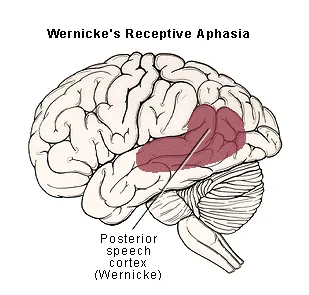Answer: Wernicke's aphasia is usually characterized by jumbled, meaningless speech and poor comprehension.
Wernicke's aphasia is a language disorder. It is sometimes also called receptive aphasia or fluent aphasia. A person may develop Wernicke's aphasia as a result of brain injury, particularly to the left posterior temporal areas.
People with this language disorder may still have intact intellectual and cognitive capabilities as long as language is not involved.
The main symptom of Wernicke's aphasia is that their capacity for production of language is unaffected, but their ability to produce meaningful language is impaired. Therefore, their speech is often meaningless but effortless. This is sometimes called "word salad."
These people are often not aware of their deficits, and do not realize that what they are saying doesn't make sense.
People with Wernicke’s aphasia have different symptoms from those with Broca’s aphasia, who have difficulty with production of language.
Cause
The most frequent cause of Wernicke's aphasia is brain injury resulting from a stroke. Strokes happen when a blood vessel, either in the brain or in the subarachnoid space of the meninges, ruptures and blood spills into the brain tissue. Strokes can happen as a result of head trauma, uncontrolled high blood pressure, or a sudden rupture of an arteriovenous malformation. More specifically, the main blood vessel that innervates the brain structures damaged in Wernicke's aphasia is the left middle cerebral artery.
After a stroke, blood damages the brain tissue. Most commonly, injured brain tissue in the posterior end of the temporal lobes may lead to this receptive aphasia. These structures are sometimes also called Wernicke's area, and they correspond to the posterior end of Brodmann area 22.
A model of understanding the pathway of signaling that is necessary for language understanding and production is the Wernicke-Geschwind model.
Treatment
Speech therapy may be effective in reversing the symptoms of Wernicke's aphasia. With this therapy, the clinician will start by asking the patient to demonstrate comprehension of individual words. There will be a layout of several images, and after the clinician says a word, the patient will be asked to point to the picture that matches the word.
The brain also demonstrates tremendous plasticity following injury. For example, it has been demonstrated that after damage to these Wernicke areas of language comprehension, other brain structures such as those in the right hemisphere and cortical areas adjacent to the injury site begin to carry out those functions.
